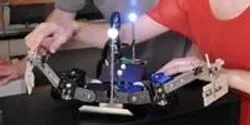Engineering

Using star-shaped block co-polymer structures as tiny reaction vessels, researchers have developed an improved technique for producing nanocrystals with consistent sizes, compositions and architectures – including metallic, ferroelectric, magnetic, semiconductor and luminescent nanocrystals.
| 4 min read

Using bundles of vertical zinc oxide nanowires, researchers have fabricated arrays of piezotronic transistors capable of converting mechanical motion directly into electronic controlling signals. The arrays could help give robots a more adaptive sense of touch, provide better security in handwritten signatures and offer new ways for humans to interact with electronic devices.
| 4 min read

For sea turtle hatchlings struggling to reach the ocean, success may depend on having flexible wrists that allow them to move without disturbing too much sand. A similar wrist also helps a robot known as “FlipperBot” move through a test bed, demonstrating how animals and bio-inspired robots can together provide new information on the principles governing locomotion on granular surfaces.
| 4 min read

Sandia National Laboratories researchers Lisa Deibler and Arthur Brown had a ready-made problem for their computer modeling work when they partnered with the National Nuclear Security Administration’s Kansas City Plant to improve stainless steel tubing that was too hard to meet nuclear weapon requirements.
| 4 min read

Surgical robots could make some types of surgery safer and more effective, but proving that the software controlling these machines works as intended is problematic. Researchers at Carnegie Mellon University and the Johns Hopkins University Applied Physics Laboratory have demonstrated that methods for reliably detecting software bugs and ultimately verifying software safety can be applied successfully to this breed of robot.
| 3 min read








